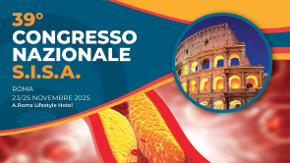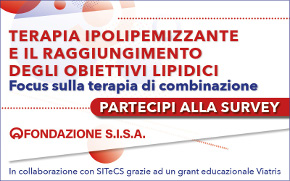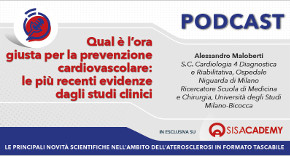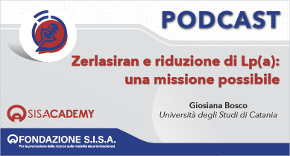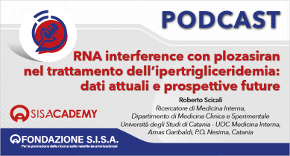 Rivista in lingua italiana
Rivista in lingua italiana
riservata ai Soci SISA
Ultimo numero:
Anno 16 • N.1/2025
Abstract
Niacin in Patients with Low HDL Cholesterol Levels Receiving Intensive Statin Therapy
AIM-HIGH Investigators, Boden WE, Probstfield JL, Anderson T, Chaitman BR, Desvignes-Nickens P, Koprowicz K, McBride R, Teo K, Weintraub W.
N Engl J Med 2011;365:2255-2267
BACKGROUND: In patients with established cardiovascular disease, residual cardiovascular risk persists despite the achievement of target low-density lipoprotein (LDL) cholesterol levels with statin therapy. It is unclear whether extended-release niacin added to simvastatin to raise low levels of high-density lipoprotein (HDL) cholesterol is superior to simvastatin alone in reducing such residual risk.
METHODS: We randomly assigned eligible patients to receive extended-release niacin, 1500 to 2000 mg per day, or matching placebo. All patients received simvastatin, 40 to 80 mg per day, plus ezetimibe, 10 mg per day, if needed, to maintain an LDL cholesterol level of 40 to 80 mg per deciliter (1.03 to 2.07 mmol per liter). The primary end point was the first event of the composite of death from coronary heart disease, nonfatal myocardial infarction, ischemic stroke, hospitalization for an acute coronary syndrome, or symptom-driven coronary or cerebral revascularization.
RESULTS: A total of 3414 patients were randomly assigned to receive niacin (1718) or placebo (1696). The trial was stopped after a mean follow-up period of 3 years owing to a lack of efficacy. At 2 years, niacin therapy had significantly increased the median HDL cholesterol level from 35 mg per deciliter (0.91 mmol per liter) to 42 mg per deciliter (1.08 mmol per liter), lowered the triglyceride level from 164 mg per deciliter (1.85 mmol per liter) to 122 mg per deciliter (1.38 mmol per liter), and lowered the LDL cholesterol level from 74 mg per deciliter (1.91 mmol per liter) to 62 mg per deciliter (1.60 mmol per liter). The primary end point occurred in 282 patients in the niacin group (16.4%) and in 274 patients in the placebo group (16.2%) (hazard ratio, 1.02; 95% confidence interval, 0.87 to 1.21; P=0.79 by the log-rank test).
CONCLUSIONS: Among patients with atherosclerotic cardiovascular disease and LDL cholesterol levels of less than 70 mg per deciliter (1.81 mmol per liter), there was no incremental clinical benefit from the addition of niacin to statin therapy during a 36-month follow-up period, despite significant improvements in HDL cholesterol and triglyceride levels. (Funded by the National Heart, Lung, and Blood Institute and Abbott Laboratories; AIM-HIGH ClinicalTrials.gov number, NCT00120289.).
N Engl J Med 2011;365:2255-2267

Area Soci
Eventi
39° Congresso Nazionale
 39° Congresso Nazionale
39° Congresso NazionaleRoma, 23-25 novembre 2025
Save the date




 Spring Meeting Gruppi Giovani SID, SIGG, SIIA, SIMI, SIPREC, SISA
Spring Meeting Gruppi Giovani SID, SIGG, SIIA, SIMI, SIPREC, SISARimini, 6-8 aprile 2025
[continua a leggere]
 SISA LIPID ACADEMY - Corso avanzato di lipidologia clinica
SISA LIPID ACADEMY - Corso avanzato di lipidologia clinicaModena, 4-5 Luglio 2024
[continua a leggere]Giornale Italiano Arteriosclerosi
HoFH today
 Rivista Italiana della
Rivista Italiana della
Ipercolesterolemia
Familiare Omozigote
Anno 6 • N.1/2024
Rivista NMCD
Diateca
[continua a leggere]
[continua a leggere]
Newsletter
il vostro indirizzo di posta elettronica
Progetto LIPIGEN

Nuovo sito dedicato al Progetto LIPIGEN
Progetto LIPIGEN - Vecchio portale
E' necessario essere loggati come utente
Lipigen per poter accedere alla pagina
PROject Statin Intolerance SISA
PROSISA – PROject Statin Intolerance SISA
E' necessario essere loggati come utente
PROSISA per poter accedere alla pagina
GILA - Lipoprotein Aferesi
Gruppo Interdisciplinare Lipoprotein Aferesi
(Accesso Gruppo GILA-Lipoprotein Aferesi)
E' necessario essere loggati come utente del Gruppo GILA per poter accedere
Gruppo Interdisciplinare Lipoprotein Aferesi
(Documentazione ad accesso libero)
Pagina informativa per medici e pazienti


